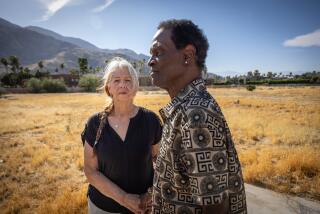DANCE REVIEW : Taylor Troupe Shows Its 3 Faces With Usual Verve
SAN DIEGO — Paul Taylor’s private domain can be playful and effervescent, darkly mysterious or tinged with romance.
Monday night, local dance buffs saw samples of all three facets of Taylor’s world at Symphony Hall.
“Esplanade,” the sunniest and possibly most brilliant work in Taylor’s vast repertory, was the dazzling centerpiece in a program that included the sentimental beauty of “Roses” and the raw, primitive spirit of “Runes.”
Because a new generation of dancers dominates the Taylor troupe these days, at least six newcomers are still finding their stride in the ensemble of 18. Nevertheless, there was enough teamwork among them Monday night to carry off the taxing program.
The springy ebullience, musicality and sheer joy of dancing that has been the company’s calling card for 35 years appears to be in no danger of disappearing.
What could be more natural than walking, running, jumping and falling? Nothing. Yet, when those mundane moves are manipulated by a master, as they were in “Esplanade,” nothing could be more dance-like, or more thrilling to watch.
These everyday movements are so deeply embedded in the modern dance lexicon that it is difficult to believe that they were revolutionary in 1975, when Taylor altered the course of modern dance with this “non-dance” work. Happily, “Esplanade” surfaced in all its pedestrian glory for the company’s first concert here in six years.
The dancers breezed through the running jumps and sliding falls of “Esplanade” with close to the level of throwaway virtuosity that we have seen in the past. And they negotiated the exhilarating rolling tumbles at breakneck speed as a Bach concerto played out its aural accompaniment. “Esplanade” has been a bona fide show-stopper since its world premiere, and it sent the San Diego audience home on a kinetic high note.
“Runes” (choreographed soon after “Esplanade” but decidedly different in style and mood), revealed Taylor’s fascination with the primordial forces in human nature.
Although this ominous and oddly disconcerting work is thoroughly modern in its movement, it is steeped in ritual, like some ancient tribal rite. There are shades of Martha Graham in the thematic content (she was Taylor’s mentor), but “Runes” has his distinct stamp. And it fit the stage in Symphony Hall well.
For this somber work, the dancers wore fur-trimmed costumes and traversed the stage in complex couplings that brought to mind images of multi-limbed deities. The dance also has a twitchy section for Taylor veteran Elie Chaib (who danced the riveting solo with bent-kneed jumps and animal energy), and some exciting passages for the dynamic Sandra Stone.
“Runes” owes a lot of its power to the interesting configurations for the full cast and the mounting tension generated by Gerald Busby’s dissonant piano piece. But Jennifer Tipton’s shadowy lighting designs did more than their share to enhance this enigmatic work.
That brief period around 1975 when both “Esplanade” and “Runes” evolved was an especially creative one for Taylor. And it was a treat to see both pieces paired on one program.
Taylor showcased only one work created in this decade, “Roses” (1985). This lush and dreamy dance for six couples was inspired by Richard Wagner’s “Siegfried Idyll,” although an adagio for clarinet and strings is tacked on to the end of the piece.
“Roses” unfolded as a striking mosaic of softly flowing phrases, punctuated by stabbing gestures. Graceful and thick with sentiment, it featured some lovely lifts and romantic images that did not always link up with the aural pastiche. However, it was a stunning showpiece for this new crop of dancers.
It began as a labyrinth of intricate moves for five pairs. But, for the final moments, while the rest of the cast languished wistfully on the floor, Cathy McCann and David Grenke captured the spotlight for a lyrical and sweetly romantic duet.
Unfortunately, this program did not show any of Taylor’s recent work, and there are many new pieces that San Diego deserves to see.
More to Read
The biggest entertainment stories
Get our big stories about Hollywood, film, television, music, arts, culture and more right in your inbox as soon as they publish.
You may occasionally receive promotional content from the Los Angeles Times.










